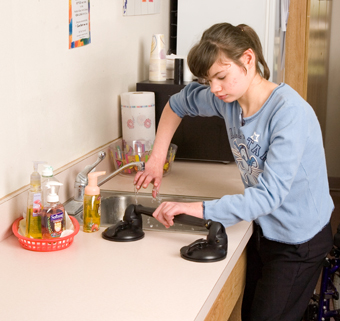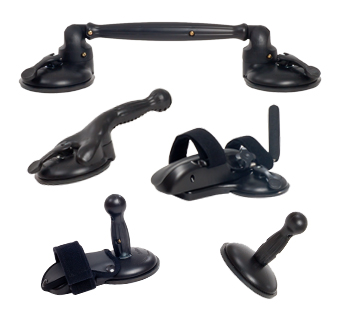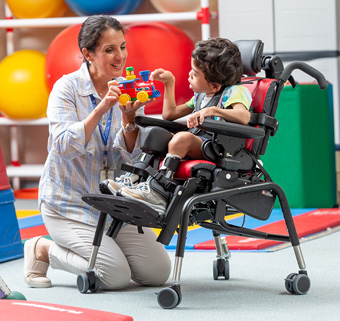Adaptive Seating: Evidence for Practice
| February 2011
Contributed by Zach Huleatt, MPT
Adaptive seating is provided for students and children that require positioning support. How children are positioned while sitting can impact the use of their upper extremities for self-feeding and other activities, as well as positively affect children at risk for spinal deformity. This article points to studies that have sought to provide research evidence regarding the therapeutic and functional value of adaptive seating.
When taken in combination, there is growing support for the use of adaptive seating as an intervention. Several reviews of the evidence for adaptive seating intervention have been conducted over the past 10 years. A review published in 1995 showed limited support (8 studies met the eligibility requirements for review) for adaptive seating and called for further and more rigorous research.1 In a review published in 2005, Roxborough and Harris combined to look at the efficacy and effectiveness of physical therapy in promoting postural control in children with cerebral palsy.2 The results of their review demonstrated similar findings to the one published in 1995, yet also showed continued growth in the volume of evidence available.2
Similarly, Stavness reviewed studies that sought to determine the effect of pelvic positioning on upper extremity function.3 The results suggest that a forward or neutral pelvic position promotes a greater deal of function than a posterior tilt of the pelvis.3 This finding, however, is conflicted and appears to be based in part on the functional level of the subjects. For example, the work of McClenaghan and colleagues suggests that an anteriorly tilted position showed no benefit to subjects.4 More recently, Hadders-Algra et al demonstrated that the relationship between pelvic position and function differs, based on the level of involvement of the client.5 This finding helps to explain some of the discrepancies between previous studies.
Support for Adaptive Chairs
What follows is a brief summary of some of the research that shows support for adaptive seating and active sitting.
Hulme looked at how adaptive seating increases or improves the perception of the amount or quality of social interaction, tracking, grasping, self-feeding, and positioning.6, 7 Caregivers were surveyed to collect the data. The results showed that adaptive seating had a positive impact. The work of Nwaobi and colleagues is important in that it underscores how adaptive seating promotes both health and function.8, 9 Holmes and colleagues demonstrated that, if applied correctly, adaptive seating can be used to promote correction of scoliosis in children with cerebral palsy.10 The work of Myhr and colleagues is significant in that it demonstrates that adaptive seating promoted function and postural control during use and prevents deterioration of the measured skill set over a period of five years.11
The research that exists, points to adaptive seating as something that promotes health and function. However, due to the variability of the population that requires adaptive seating, it is not responsible to create broad clinical guidelines based on the current evidence. Although strong evidence remains scarce, it appears that the body of evidence is gradually growing.2 The reader is encouraged to read the reviews mentioned above for a more thorough understanding of this topic.
Reference List
- Roxborough L. Review of the efficacy and effectiveness of adaptive seating for children with cerebral palsy. Assist Technol 1995;7(1):17-25. PubMed Link
- Harris SR, Roxborough L. Efficacy and effectiveness of physical therapy in enhancing postural control in children with cerebral palsy. Neural Plast 2005;12(2-3):229-243. PubMed Link
- Stavness C. The effect of positioning for children with cerebral palsy on upper-extremity function: a review of the evidence. Phys Occup Ther Pediatr 2006;26(3):39-53. PubMed Link
- McClenaghan BA, Thombs L, Milner M. Effects of seat-surface inclination on postural stability and function of the upper extremities of children with cerebral palsy. Dev Med Child Neurol 1992;34(1):40-48. PubMed Link
- Hadders-Algra M, van der Heide JC, Fock JM, Stremmelaar E, van Eykern LA, Otten B. Effect of Seat Surface Inclination on Postural Control During Reaching in Preterm Children With Cerebral Palsy. Phys Ther 2007. PubMed Link
- Hulme JB, Gallacher K, Walsh J, Niesen S, Waldron D. Behavioral and postural changes observed with use of adaptive seating by clients with multiple handicaps. Phys Ther 1987;67(7):1060-1067. PubMed Link
- Hulme JB, Shaver J, Acher S, Mullette L, Eggert C. Effects of adaptive seating devices on the eating and drinking of children with multiple handicaps. Am J Occup Ther 1987;41(2):81-89. PubMed Link
- Nwaobi OM. Seating orientations and upper extremity function in children with cerebral palsy. Phys Ther 1987;67(8):1209-1212. PubMed Link
- Nwaobi OM, Smith PD. Effect of adaptive seating on pulmonary function of children with cerebral palsy. Dev Med Child Neurol 1986;28(3):351-354. PubMed Link
- Holmes KJ, Michael SM, Thorpe SL, Solomonidis SE. Management of scoliosis with special seating for the non-ambulant spastic cerebral palsy population–a biomechanical study. Clin Biomech (Bristol , Avon ) 2003;18(6):480-487. PubMed Link
- Myhr U, von Wendt L, Norrlin S, Radell U. Five-year follow-up of functional sitting position in children with cerebral palsy. Dev Med Child Neurol 1995;37(7):587-596. PubMed Link




